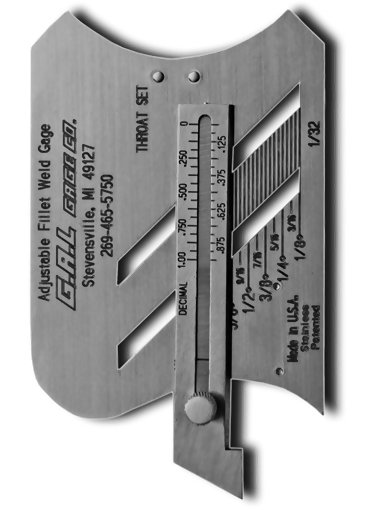The Ultimate Overview to Fillet Weld Quality Control: Ensuring Strength and Durability in Your Welded Joints
In the realm of welding, making certain the strength and resilience of fillet welds is extremely important for the integrity of bonded joints. As we begin on this exploration of fillet weld top quality control, we will uncover vital aspects that affect weld stamina, dig into reliable inspection techniques, and discuss methods for avoiding common weld issues.
Importance of Fillet Weld Quality Control
Making certain proper fillet weld quality assurance is critical in ensuring the structural honesty and long life of bonded elements in different sectors. Fillet welds are frequently made use of in architectural steelwork, bridges, pressure vessels, pipelines, and various other critical framework where the stamina of the weld is essential to total safety and security and efficiency. Quality assurance procedures such as visual evaluations, non-destructive testing, and adherence to welding treatments help identify possible flaws like lack of fusion, insufficient infiltration, undercutting, or too much reinforcement.
Secret Variables Influencing Weld Toughness
Achieving ideal weld stamina needs mindful consideration of numerous essential variables that influence the stability and toughness of the bonded joint. The very first important element is proper joint preparation, which includes cleansing the base metals to remove any impurities that might deteriorate the weld. Furthermore, the fit-up of the joint is vital to make certain correct infiltration and combination of the filler product.
The selection of the proper welding technique and criteria additionally plays a considerable role in identifying weld strength. Aspects such as heat input, travel rate, and electrode angle can affect the top quality of the weld. Keeping the appropriate interpass temperature during multi-pass welding is important to protect against breaking and make sure a solid bond in between the layers.
Moreover, the choice of filler material and its compatibility with the base steels is vital for achieving high weld stamina. Utilizing filler material with the appropriate mechanical properties can improve the total honesty of the weld. Post-weld heat treatment and proper inspection strategies are important actions in ensuring the strength and resilience of the welded joint.
Evaluation Techniques for Weld Stability

One more critical examination technique is fluid penetrant screening, where a liquid dye is used to the weld surface - Gauge Fillet Weld. The color seeps into any surface-breaking issues, making them visible under UV light. This check that method is reliable for finding problems that might not show up to the nude eye


Ultrasonic screening is additionally commonly utilized for inspecting weld honesty. High-frequency acoustic wave are routed into the weld, and any type of interruptions in the sound wave pattern show potential issues like fractures or absence of fusion.
These assessment approaches play an important role in ensuring special info the high quality and reliability of welds, ultimately adding to the total stamina and resilience of bonded joints in industrial setups.
Avoiding Common Weld Flaws
In order to keep the structural stability of welded joints in industrial applications, it is essential to implement preventive steps to resolve typical weld issues. One usual defect is absence of fusion, where the filler material fails to bond effectively with the base steels, leading to vulnerable points in the weld. This can be avoided by making certain appropriate warm control and making use of the appropriate welding strategy.
Another frequent problem is porosity, triggered by gas entrapment in the weld steel throughout the welding procedure. To stop this, it is important to clean the base steels extensively, utilize dry electrodes, and maintain an appropriate welding environment with correct ventilation.
Additionally, cracks in welds can jeopardize the joint's toughness. To prevent this issue, it is very important to control the cooling price after welding, use preheating when needed, and select suitable welding parameters.
Enhancing Bonded Resilience With Appropriate Strategies
To reinforce the durability and dependability of bonded structures, utilizing innovative welding strategies is vital. One critical method to enhance weld sturdiness is to make certain correct weld grain positioning. By placing the weld bead precisely within the joint, the weld's strength and resistance to fatigue can be considerably improved. Furthermore, using the appropriate welding parameters, such as voltage, current, and take a trip rate, is vital for attaining a long lasting weld. These parameters straight impact the weld's infiltration, combination, and general top quality, contributing to its durability.
Picking the ideal filler steel and ensuring the cleanliness of the base steels can avoid inclusions and other defects that might jeopardize the weld's sturdiness. his response By executing these proper strategies, welders can guarantee that their bonded joints show remarkable toughness and sturdiness, satisfying the greatest high quality requirements.
Verdict
In final thought, keeping high top quality control standards for fillet welds is vital for making sure the stamina and resilience of bonded joints. By understanding the crucial elements affecting weld strength, using evaluation approaches for weld integrity, protecting against typical weld issues, and using correct methods, welders can boost the total durability of their welds. It is imperative to focus on high quality control steps to generate long-lasting and reliable bonded joints.
In the realm of welding, making sure the strength and toughness of fillet welds is extremely important for the stability of welded joints. As we begin on this exploration of fillet weld high quality control, we will certainly discover necessary variables that influence weld toughness, dig into reliable evaluation techniques, and discuss strategies for stopping common weld problems.Achieving optimal weld strength calls for cautious factor to consider of numerous crucial variables that affect the stability and toughness of the bonded joint (Gauge Fillet Weld).In verdict, maintaining high quality control standards for fillet welds is essential for ensuring the toughness and resilience of bonded joints. By comprehending the essential aspects affecting weld strength, making use of examination approaches for weld stability, avoiding usual weld flaws, and using correct strategies, welders can boost the general longevity of their welds
Comments on “Understanding Gauge Fillet Welds: Tips for Perfect Measurements and Execution”